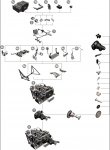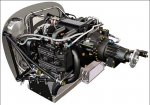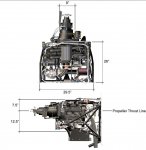По данным разведки у DeltaHawk есть какая-то неразрешимая в скором времени проблема и лучше его не ждать.... а то состариться можно.
Чрезвычайно сожалею по этому поводу:этот мотор присутствует и в моих планах.Интересно все же - в чем,конкретно,проблема - и будет ли она решена в обозримое время.Ваш контракт,кстати,более не выполняется?
Я поменял решение на Субарик.
Решение понятное и очевидное:следует лишь учесть некоторые замечания
3. Цена не выше авиационного двига, но кушает авто топливо, а не 100LL, который дороже и его нет везде.
Цена действительно,не выше,но и не ниже авиационного мотора.Однако,по большому счету,эти изделия авиамоторами не являются.Хотя бы по причине зажигания - оно,во-первых,не дублировано (1 свеча на цилиндр),а,во-вторых,не отделено от общей системы электроснабжения,что совершенно катастрофически снижает отказобезопасность (есть такое неудобопроизносимое слово).Суть этого сводится к тому,что приемлемым считается,если ЛЮБОЙ ЕДИНИЧНЫЙ ОТКАЗ не приводит к аварийным последствиям.Т.е.КЗ в любой точке электросети неизбежно приведет к потере зажигания,остановке двигателя и остальных следствий.В АВИАЦИОННОМ моторе подобные ситуации исключены как класс.На сраном двухтактном Ротаксе-582 и то стоят по две свечи на цилиндр ,работающих от магнето.
Безусловно,ставить такой мотор на самолет можно (и ставят),однако придется уже летать с оглядкой.Так или иначе,цена представляется высоковатой для приспособленного мотора.
4. По отзывам из множества независимых источников он очень надежный.
В качестве автомобильного - конечно;в приложении к авиации - см.выше.
7. Всё равно, самолет будет сертифицироваться как ЕЭВС и смысла ставить сертифицированный двиг только из-за бумажки смысла нет.
Насколько помнится,было большое желание производить неблизкие перелеты - не уверен,что риск при этом носит приемлемый уровень (учитывая привязанность Velocity к твердым длинным полосам и практическую невозможность внеаэродромной посадки)
Для информации - команда RV так же думает о смене двигов в сторону Субарика (и ИМХО правильно делает) ..... замучались видимо 100LL возить ведрами/канистрами/бочками на аэродром 😉. Как не крути, Лайкоминги превращают самолет у нас пока в кордовую модель
Лично я и в том и в другом случаях,обратил бы свой взор в сторону уже упоминавшихся чешских LOM-PRAHA.Линейка мощностей этих моторов начинается от 120 и заканчивается 260 л.с.Шестицилиндровые М337 имеют вес 146кг.
Думаю,изменение формы капота не стало бы неразрешимой задачей,а толкающий винт совместно с подобным мотором работал бы в условиях,близких к идеальным



